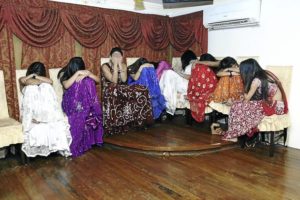
By Naila Farooq
Pakistan is a source, transit, and destination country for men, women, and children subjected to forced labor and sex trafficking. The country’s largest human trafficking problem is bonded labor, in which an initial debt assumed by a worker as part of the terms of employment is exploited, ultimately entrapping other family members, sometimes for generations.
During past few decades, human trafficking has become a major concern in the International relations. One of the reasons for this new concern is that the world is getting more globalized where flow of goods and individuals are getting more rapid. So the movement of traffickers is an indication of new complex social issues. Moreover, the rising anxiety about hostility or violence toward females have placed the issue of human smuggling on the international solution program, and its association with the criminal activities, pornographic production, forced labor, HIV/AIDS and human rights violation has created pressure to worldwide anti-trafficking efforts, predominantly in South Asian region.
Among South Asian states, Pakistan is the target state for the smuggling of male and female victims with intentions of forced labor and sexual exploitation. The reason is Pakistan seems like the most vulnerable region for human trafficking because of its massive population pyramid, rising urbanization, and poverty. So sex trade or human smuggling in Pakistan has become a multibillion-profit market, build on greed and supply on those with the least power.
The Government of Pakistan does not fully meet the minimum standards for the elimination of trafficking; however, it is making significant efforts to do so. The government approved its national strategic framework against trafficking in persons and human smuggling and reported an increase in the number of victims provided shelter in 2015 compared with 2014. The federal government and Punjab and Khyber Pakhtunkhwa provinces passed trafficking-related legislation, and some provinces investigated, prosecuted, and convicted traffickers.
The overflow of Afghan refugees in Pakistan, unemployment, permeable boundaries and formation of organized global smuggling groups has made it an opportune working atmosphere for human smugglers. Young boys are most vulnerable targets because of they often themselves access these groups in the search for a job. These victims of human or migrant smuggling are mostly found in the Middle East and European countries. According to Pakistan Thematic Group on Human Trafficking (PTGHT), the coastline between Karachi and Gwadar is often used for human trafficking for the Gulf States by road to the border of Iran from where they are picked up by gangs and transported to Greece, Italy, and Spain via ships. In case of female victims they are sold into forced, temporary or false marriages; in some cases, their new husbands move them across Pakistani borders and forced them into the sex industry in destinations like Qatar and UAE, directly or via Iran or Oman.
This part of human trafficking across borders has posed serious threats to law enforcement agencies, political decision makers and human right law’s activist in Pakistan. At first, the growth of human traffickers as organized criminal networks has undermined the very foundations of the state, simply by creating parallel structures or systems of governance. Such risks increase the level of the national expenditure on law enforcement, criminal justice systems, and security. Secondly, the overflow of illegal immigrants reflects the lack of efficiency of the law enforcement agencies. Meanwhile, the illegal immigrants do not possess proper identifications, so they can easily be used in illegal criminal or terrorist activities.
Human trafficking leads to a financial loss in the form of lost resources, remittances, and adds to the illegal profits for the criminal syndicates. According to an ILO estimates, global human trafficking produces about $31.6 billion annually, thus making it the third largest revenue generating activity and the fastest growing illegal industry in the world, surpassing other criminal enterprises except for the drug and arms trades. Meanwhile, the entry and exit of illegal immigrants into the borders also bring negative impact in a country, such as competition in trading and the local labor market. Illegal immigrants receive a minimum wage than the local labor, which certainly encourages the employers to hire illegal immigrants causing disruptions to the local job market. On the other hand, the competition and trade among the local labors would decrease due to cheap illegal workers. The cost of processing the illegal immigrants have soared. Besides the cost of capturing them, it adds to the cost of transporting them back to their respective countries of origin.
Meanwhile, the recruitment of trafficking victims as sex slaves and introduction of online porn industry have increased the risk of the cyber security in Pakistan. The overflow of the internet and mobile services with open access to exotic information and images has become a major contributor in the pornographic industry. According to estimations, there are 780,000 adult websites in Pakistan. Sometimes these sites are controlled by software companies and therefore hard to trace. So it became a standard scenario to exploit vulnerable victims in the pornographic industry. Kasur case of 2015 is a most current example of a massive child exploitation scandal in Pakistan. Many children were sexually abused by forcefully raping them.
On a societal level, the structure of the country is being threatened by immoral activities of human traffickers. In this regard, the young generation has become most vulnerable to sexual exploitation which results in a deterioration in their family relations and eventually contributes to violence and criminal activities in the society. We see much elevation in the number of rape cases and murders of very young girls and boys.
Even though sexual exploitation, prostitution, and pornography are in the limelight, they are treated as social taboos and hidden under the rug. Thus it remains an open secret in Pakistan and invisible due to lack of proper coverage in print and electronic media. Moreover, there are some allegations that human trafficking in Pakistan is aided or facilitated by some influential figures. So there is dire need to tackle trafficking as a security issue.
